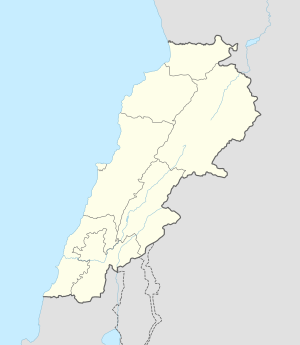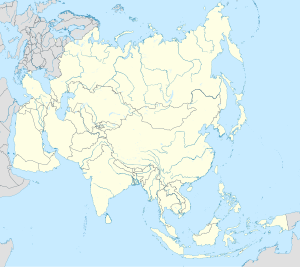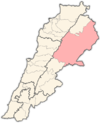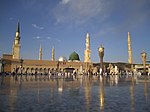Al-Nabi Shayth
Al-Nabi Shayth
ٱلنَّبِي شَيْت ٱلنَّبِي شِيْت Nabi Chit | |
|---|---|
Village | |
 Mosque of the Prophet Seth in the village of the same name | |
 Al-Nabi Shayth Location in Lebanon | |
| Coordinates: 33°52′20″N 36°06′46″E / 33.87222°N 36.11278°ECoordinates: 33°52′20″N 36°06′46″E / 33.87222°N 36.11278°E | |
| Country | |
| Governorate | Baalbek-Hermel |
| District | Baalbek[1] |
| Elevation | 4,000 ft (1,220 m) |
| Website | nabichit |
Al-Nabi Shayth (Arabic: ٱلنَّبِي شَيْت, romanized: An-Nabī Shayt, also Nabi Chit or Nabi Sheeth (Arabic: ٱلنَّبِي شِيْت, romanized: An-Nabī Sheeth), literally "The Prophet Seth"), is a village in the Valley of Beqa'[2] and District of Ba'albek[1] in Lebanon. The village was called by that name because it is considered to contain the burial-site of Seth the son of Adam. A mosque was built on the burial site and it contains the grave of Seth inside the mosque (a rival tradition placed Seth's tomb in the Palestinian village of Bashsheet, and likewise in the Iraqi city of Mosul).[3] The village is also the hometown of Abbas al-Musawi, who was a leader of Hezbollah, and an influential Twelver Shi'ite cleric. The village of Al-Nabi Sheeth is predominantly inhabited by people with the surnames Helbawi, Al-Moussawi, Hazimeh and Chokr.[citation needed]
History[]
Ibn Jubayr (1145–1217 CE) noted:
the two graves of Seth and Noah [..] are in the Bika', and two days' journey from Damascus. One who measured the tomb of Sheeth (Seth), reported to us that it was 40 fathoms (ba') long, and the tomb of Nuh (Noah) was 30. The tomb of Noah's son lies side-by-side with that of Noah. There is a building over the tombs, and an endowment for charitable purposes.
— Ibn Jubayr[2]
In 1838, Eli Smith noted En-Neby Sheeth as a "Metawileh" village in the district of Baalbek.[1]
See also[]
References[]
- ^ Jump up to: a b c Robinson, E.; Smith, E. (1841). Biblical researches in Palestine, Mount Sinai and Arabia Petraea : a journal of travels in the year 1838. 3 (2nd appendix). Boston, the U.S.A.: Crocker & Brewster. p. 145.
- ^ Jump up to: a b Le Strange, G. (1890). Palestine Under the Moslems: A Description of Syria and the Holy Land from A.D. 650 to 1500. London: Committee of the Palestine Exploration Fund. p. 422. OCLC 1004386.
- ^ "ISIS destroys Prophet Sheth shrine in Mosul". Al Arabiya News. 2014-07-26.
Bibliography[]
External links[]
- Nabi Chit, Localiban
- Populated places in Baalbek District
- Shia Muslim communities in Lebanon
- Lebanon geography stubs






